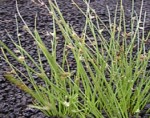Scientific Name: Cyperus laevigatus
Also Known As: The Hawaiian Mat Making Flatsedge
Indigenous: All HI except Lana’i and Kaho’olawe
Description: A small rounded sedge with narrow culms up to about 2 ft. tall ending up into a sharp point. The flowers are small spikelets that usually come down about an inch or two from the tip, protrude out from the side and are light brown-gray in color.
Distribution: This is an indigenous plant found throughout subtropical regions worldwide, here in Hawaii it is most likely found in coastal areas and along the margins of ponds and marshes on the islands of Ni’ihau, Kaua’i, O’ahu, Moloka’i, Maui, Hawai’i, and Laysan in the Northwestern part of the Hawaiian Island chain.
Cultural Uses: This plant is famous and highly valued by Hawaiians for its use to weave mats and more recently hats. In fact even the author Robert Louis Stevenson wrote that there were no mats finer than the makaloa mats of Hawaii during his travels throughout the Pacific.
Landscape Use and Care: This plant looks great in ponds and can be used as an accent around rock features. It does best in full sun and its roots can tolerate being fully submerged underwater. Just put the whole pot in the pond and weigh it down with some rocks. It also does well planted in areas of your garden that for whatever reason continuously stay wet. Few pests bother this plant so that makes taking care of it that much easier. Right now this plant is available at the Home Depots in Pearl City as well as in Honolulu for about $8 a piece, a great price for a plant that is seldom offered for sale.
Additional Info: Our lowland streams and marshes are vital habitats for many native flora and fauna and are essential in the prevention of floods. This plant along with numerous other native sedges and rushes, shrubs and groundcovers are main components of this ecotype which is now dominated by alien plants and animals. More work needs to be done to reestablish these zones as native habitats not only for the plant and animals sake, but to reduce and or prevent the threat of lowland flooding.
Makaloa
